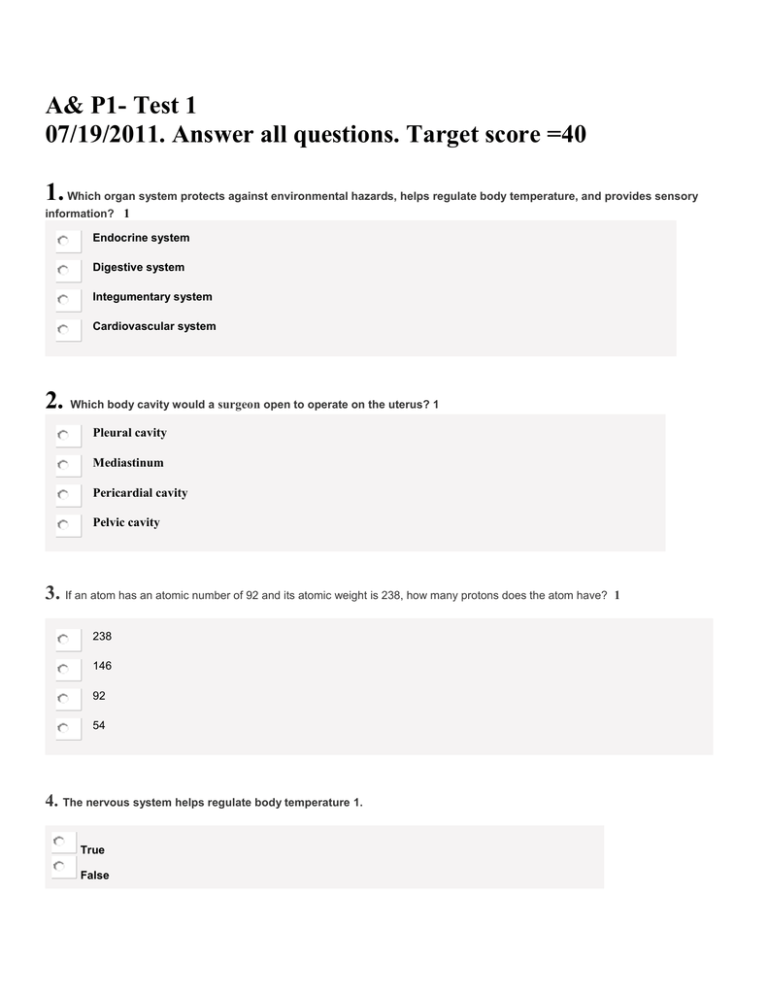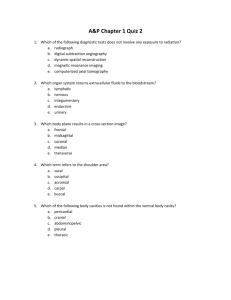A P1 Test1.doc
advertisement

A& P1- Test 1 07/19/2011. Answer all questions. Target score =40 1. Which organ system protects against environmental hazards, helps regulate body temperature, and provides sensory information? 1 Endocrine system Digestive system Integumentary system Cardiovascular system 2. Which body cavity would a surgeon open to operate on the uterus? 1 Pleural cavity Mediastinum Pericardial cavity Pelvic cavity 3. If an atom has an atomic number of 92 and its atomic weight is 238, how many protons does the atom have? 238 146 92 54 4. The nervous system helps regulate body temperature 1. True False 1 5. Put the following levels of organization into the proper order, matching from least complex (1) to most complex (6): Using the pull-down menus, match each item in the left column to the corresponding item in the right column. 5.1 1 Chemical or molecular level 5.2 2 Cellular level 5.3 3 Tissue level 5.4 4 Organ system level Organism level 5.5 5 Organ level 5.6 6 6. Of the two general mechanisms involved in homeostatic regulation, refers to local processes and extrinsic regulation involves the nervous system or the endocrine system. 1 7. The is a muscular sheet that divides the ventral body cavity into the thoracic and abdominopelvic cavity. 1 8. What is the difference between histology and cytology? 2 9. Why is it important for healthcare professionals to understand the structure and function of all the systems in the human body, although they may spend their professional lives working with a single system? 1 10. In which body cavity are the female reproductive organs located? 1 Mediastinum Pleural cavity Pelvic cavity Abdominal cavity 12. The muscles are deep to the skin. 1 True False 13a. What are the two types of energy? Give an example of each. 3 13b. How does the Law of conversion of energy apply to the above two types of energy: 2 14. Label the following directional terms in the diagram. 4 For each item below, use the pull-down menu to select the letter that labels the correct part of the image. 14.1 Superior or cranial 14.2 Anterior or ventral 14.3 Inferior or caudal 14.4 Posterior or dorsal 14. The three subatomic particles that are stable constituents of atomic structure are: 1 carbon, hydrogen, and oxygen atoms, molecules, and compounds cells, tissues, and organs protons, neutrons, and electrons 15. A solute that dissociates to release hydrogen ions and causes a decrease in pH is: 1 a salt an acid a base water 16. The most important high-energy compound found in the human body is: 1 ATP DNA UTP GTP 17. The chemical makeup of a lipid molecule is different from a carbohydrate in that the lipid molecule: 1 contains equal amounts of carbon and oxygen in its molecular structure contains twice as much oxygen as the carbohydrate contains much less oxygen than a carbohydrate having the same number of carbon atoms the chemical makeup is the same 18. The type of bond that has the most important effects on the properties of water and the shapes of complex molecules is the: 1 polar covalent bond hydrogen bond covalent bond ionic bond 19. For each item below, use the pull-down menu to select the letter that labels the correct part of the image. 20.1Quarternary structure 20.2 Primary structure 20.3 Secondary structure 20.4 Tertiary structure 4 20. Match each property with the corresponding term: 5 Using the pull-down menus, match each item in the left column to the corresponding item in the right column. 20.1 Means "does not associate well with water" 20.2 Particles dispersed in a medium 20.3 Medium in which particles are dispersed Hydrophobic Electrolyte Solvent Hydrophilic 20.4 Means "interacts well with water" Solute 20.5 Dissolves to ions that conduct current





